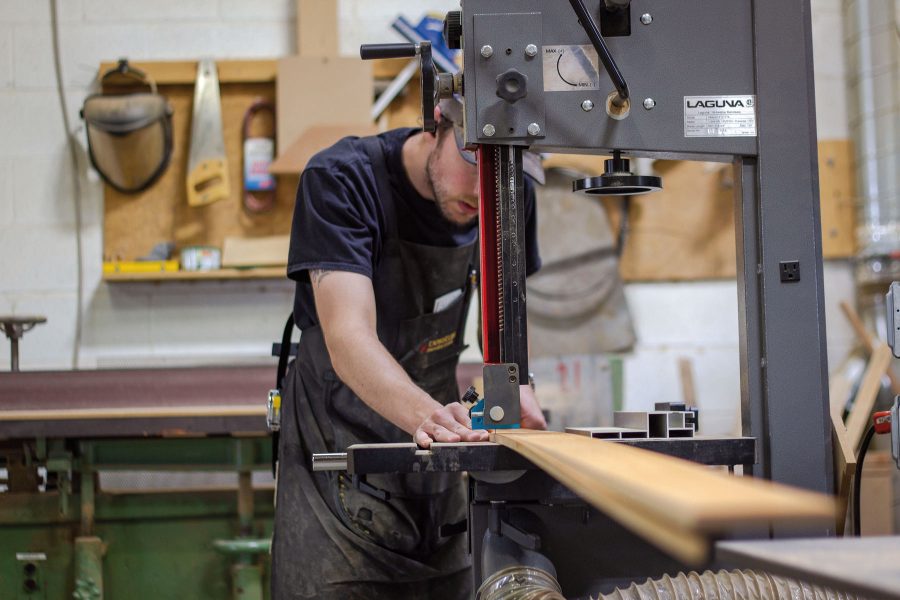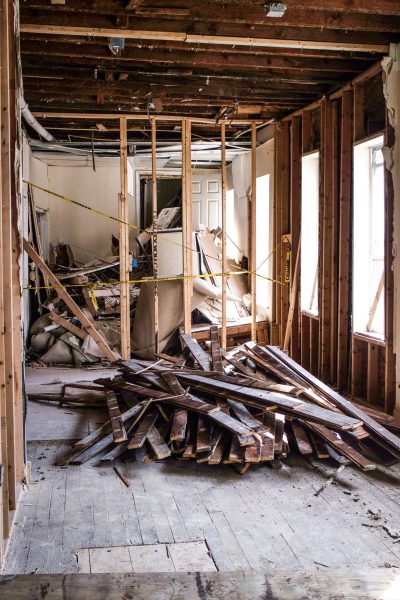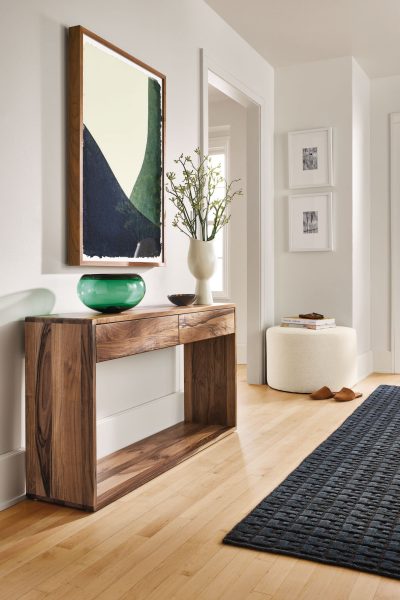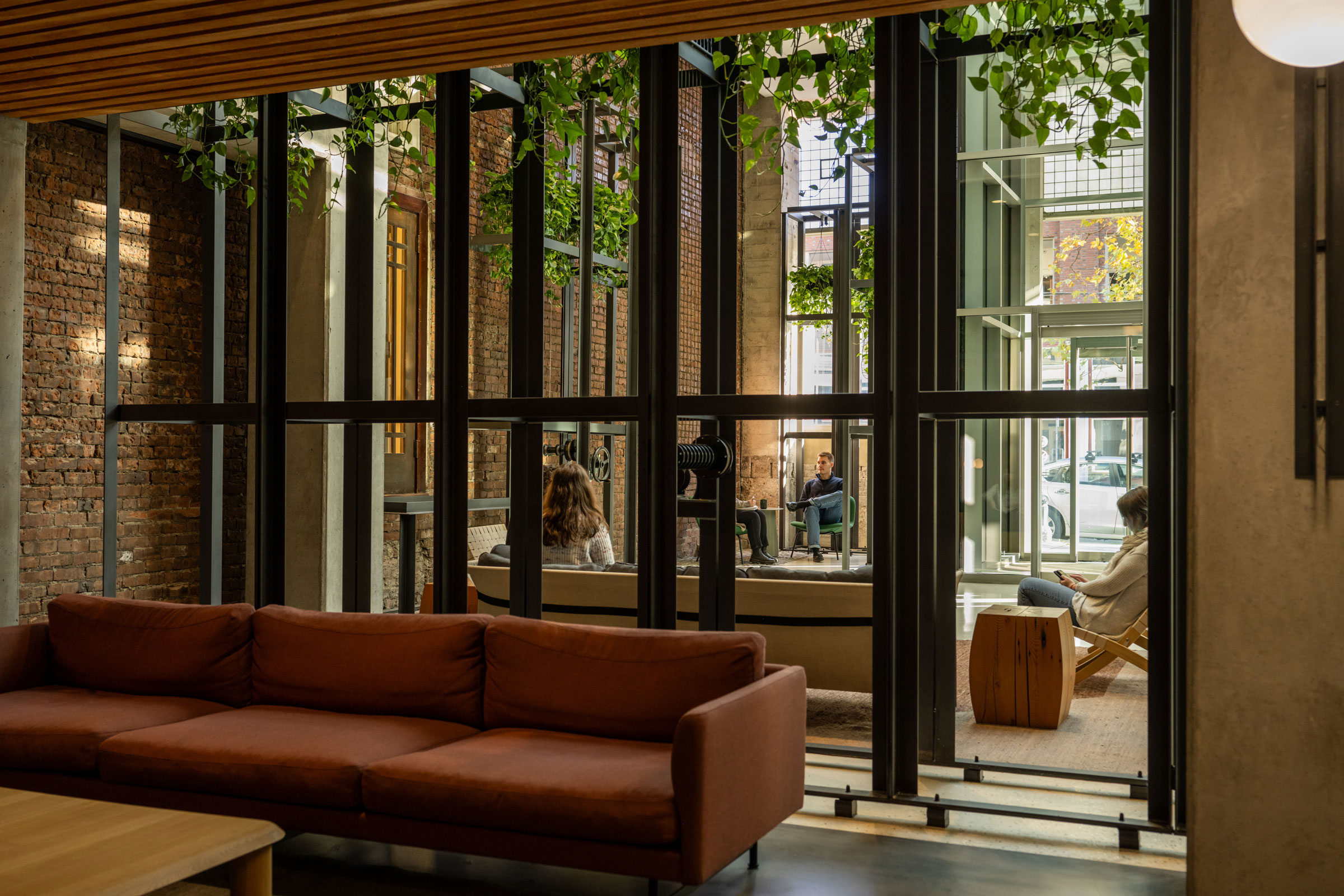Story at a glance:
- Room & Board is a 100% employee-owned modern furniture and home decor retailer based in Minneapolis and committed to all things sustainable.
- More than 200 of Room & Board’s upholstery fabrics have GREENGUARD Gold certification. Ninety percent of Room & Board’s manufacturing happens in the US.
Based in Minneapolis and celebrating 45 years in 2025, Room & Board, and Room & Board for Business, the brand’s commercial arm, is a 100% employee-owned modern furniture and home decor retailer that proves its commitments in both its actions and its words.
The company has more than 1,100 employees and 22 stores nationwide and has been following sustainable practices since day one. They’re a Certified B Corporation working toward 100% sustainably sourced wood by end of year (98% achieved as of summer 2025), and they support a large number of American craftspeople—more than 90% of their products are made in the US by American artisans.
“We always say our purpose is people,” Emily McGarvey, director of sustainability at Room & Board, tells me from her office in Minneapolis one summer Monday. As a B Corp, she says the company has to be committed not just to profit but also to people and the planet. It also makes good business sense, as customers demand it.
“It’s a really fun time to be in sustainability and in furniture and the built environment in general,” McGarvey says. “There are a lot of new things happening, and there’s a lot of excitement for sustainability. We see our customers wanting to engage more and more with sustainable products and asking about sustainability and different certifications.”
Room & Board has learned its customers interact with sustainability data on roomandboard.com similarly to how they use reviews. Often after a customer, architect, designer, or builder has made purchase decisions and is getting ready to buy, they read reviews to feel affirmed they’ve made a good choice. “People are interacting with the sustainability information in the same way,” McGarvey says. “It’s affirming for people that they’re making a good choice from a good company with good, sustainable materials and good practices. And it’s influencing the purchase; people want to feel good about the purchase, and we want customers to love the furniture they’re putting in their homes.”
Forward-Thinking Strategies
- The Urban Wood Project delivers sustainable furniture and decor made from reclaimed US urban wood. Photo courtesy of Room & Board
- Room & Board’s Urban Wood Project sources wood in part from structures slated for demolition, giving wood a second life as furniture. Photo courtesy of Room & Board
McGarvey says sustainability in modern furniture manufacturing starts with having high-quality, trend-proof design. For Room & Board that means creating furniture that can last generations. “It’s durable, and it’s a modern design that will live beyond this or next year’s trends,” she says. “From a sustainability perspective that’s probably the most important.”
The materials that make up these products matter greatly. “I’ve seen some research that shows that, from an embodied carbon impact perspective, materials are 75% of the total carbon impact. Choosing materials is really important when you’re thinking about sustainability. At the highest and simplest level it’s really about choosing renewable and recycled materials wherever possible. That really allows you to reduce your carbon impact,” McGarvey says. “After that, manufacturing and distribution are both in that 10 to 15% range of carbon impact. From a manufacturing perspective, how do you have the most efficient processes? How do you have energy-efficient equipment?Our vendor partners are starting to look at renewable electricity and rooftop solar, which is fantastic.”
As for Room & Board’s own building efficiencies, the company used 65% renewable electricity in 2024 and achieved an 85% diversion of operational waste. They also designed a rooftop solar array to generate 120% of their Minnesota headquarters’ electricity needs.
On the distribution side, 90% of Room & Board’s manufacturing happens in the US. “That’s eliminating the carbon impacts of shipping product overseas. That alone has a big impact from a carbon perspective,” McGarvey says.
Sustainable Material Choices
- The Renew chair launched in summer 2025 with a 99% bio-based composition thanks to renewable material choices. Photo courtesy of Room & Board
- The Graft table from Room & Board is made from reclaimed wood. Photo courtesy of Room & Board

Photo courtesy of Room & Board
Using as many third-party certified, bio-based, and recycled materials as possible is a big emphasis at Room & Board, McGarvey says. The Renew chair launched in June 2025 and is 99% bio-based.
Renew features clean lines and gentle curves, inspired by classic Scandinavian design, with reclaimed wood as its frame. Instead of using the polyurethane foam common in the industry, Room & Board used a combination of natural latex and wool for the cushion. The chair’s upholstery is nearly 80% wool and cotton and 20% nylon. “We were really trying to push to have the maximum amount of bio-based and renewable materials,” McGarvey says.
Bio-based materials are becoming a hot topic across the industry. “I see that too in the commercial world,” McGarvey says. “People are thinking more about wood versus some of the steel that’s happening in some of the buildings, which I think is really exciting—where can we use wood in different ways?”
Room & Board’s Urban Wood Project uses reclaimed wood from trees that come down in cities for various reasons, including from homes and structures slated for demolition and trees removed for disease, maintenance, or storm damage. “We’re diverting that wood from the landfill and turning it into some really beautiful, high-quality furniture. The Graft end table is a really great example of that.”
McGarvey says Room & Board’s sustainably sourced wood policy requires they use wood from responsibly managed forests. She estimates 80% of the wood used by the company is solid wood versus engineered wood and says 85% of that wood comes from responsibly managed forests in the US or Canada. Any imported wood must be third-party certified by FSC, PEFC, or SFI, she says.
Plans for the Future

Tangent from Haddy is a 3D-printed table available at Room & Board. Photo courtesy of Room & Board
“We’re really trying to be a sustainability leader who positively impacts society and the world,” McGarvey says.
Room & Board is working to get to 100% renewable electricity by 2030 and is at about 65% currently. The company is also working toward zero waste across facilities, distribution centers, and stores. “Furniture has a lot of cardboard and plastic, and we were able to find a nationwide plastic partner, Trex, who makes composite decking, to buy plastic of all colors; as long as it has a little bit of a stretch they’ll take it. They’re turning that into composite decking, and that really helps us be able to recycle a lot of our plastic waste, which is really fantastic.”
McGarvey expects excitement around bio-based and recycled materials to continue to grow and looks to the rapidly expanding material innovation in leathers and upholstered fabrics as one example and 3D printing as another.
“We already have some 3D printed outdoor tables and planters from Haddy, a 3D printing company out of Florida. We also have some 3D printed bio-based plastic lighting coming from Gantri that’s coming in January 2026,” she says. “The whole renewable, bio-based side of things is really exciting.”
As for waste, she looks forward to leaders in the industry continuing to innovate. “I think the whole furniture industry is still trying to figure out what to do with the furniture that does end up in landfill at the end of its life cycle. The US has made progress with mattress recycling—largely because it’s been regulated and the supply chain is in place. But we don’t necessarily have a great logistical supply chain setup to handle case goods and upholstered furniture,” she says. “I think that’s where there will be a lot of conversation happening. It’s going to be interesting to see: Is it going to be a collaboration of retailers and manufacturers who build that supply chain, or is it going to happen through state or federal regulation? I’m not quite sure the path that’s going to happen, but I do think that there’s quite a bit of furniture going into landfills, and that’s something the industry has to work together on to figure out.”







